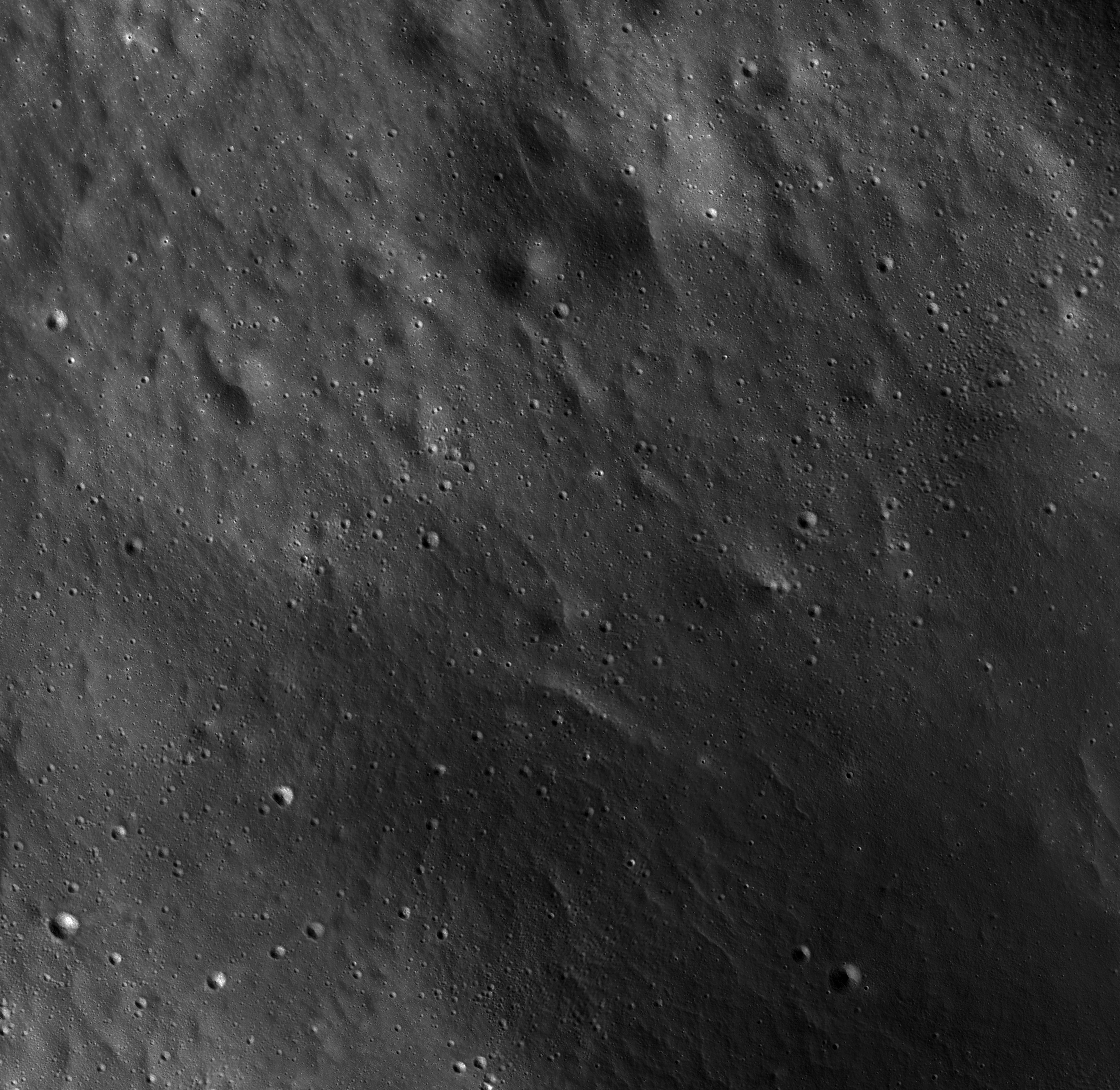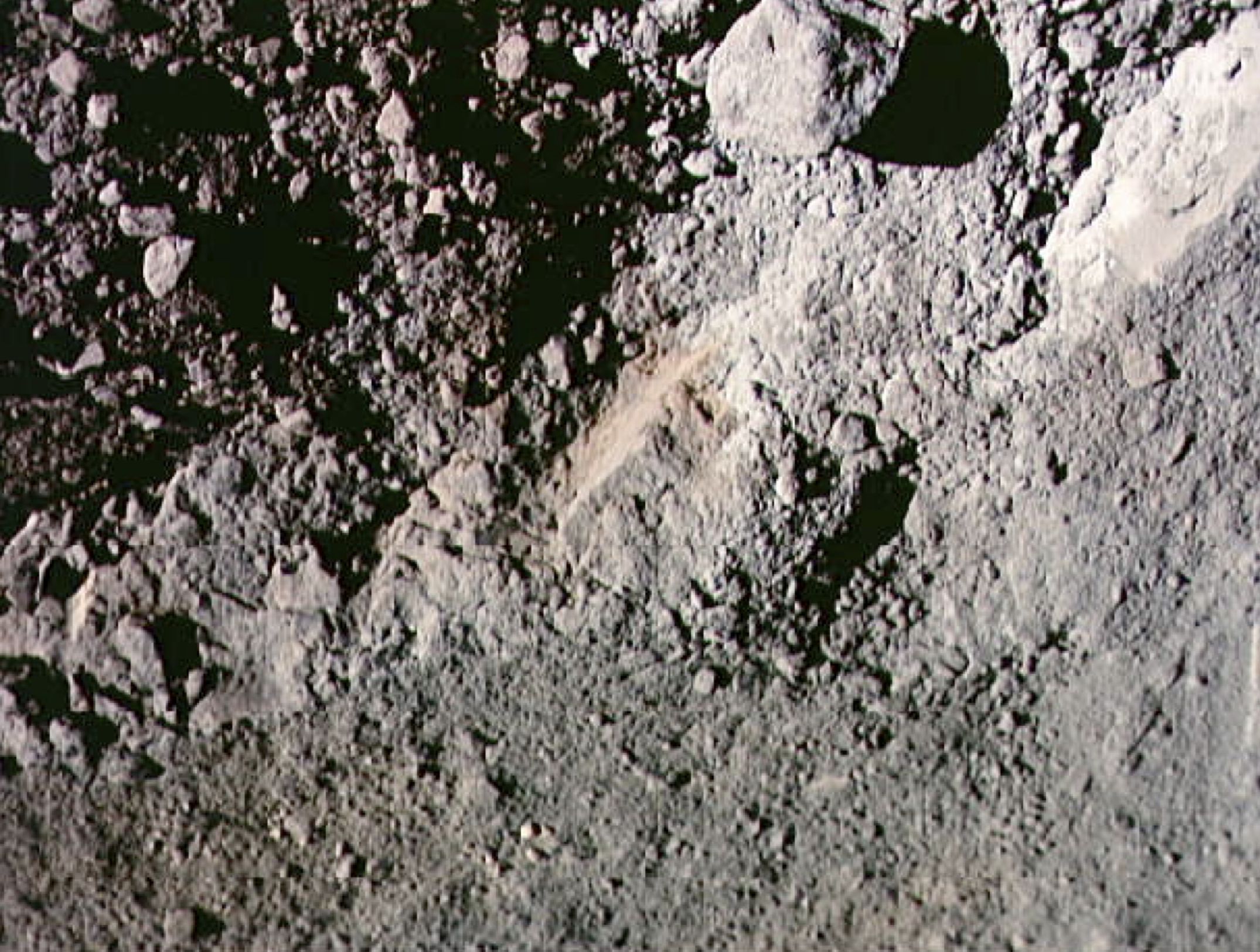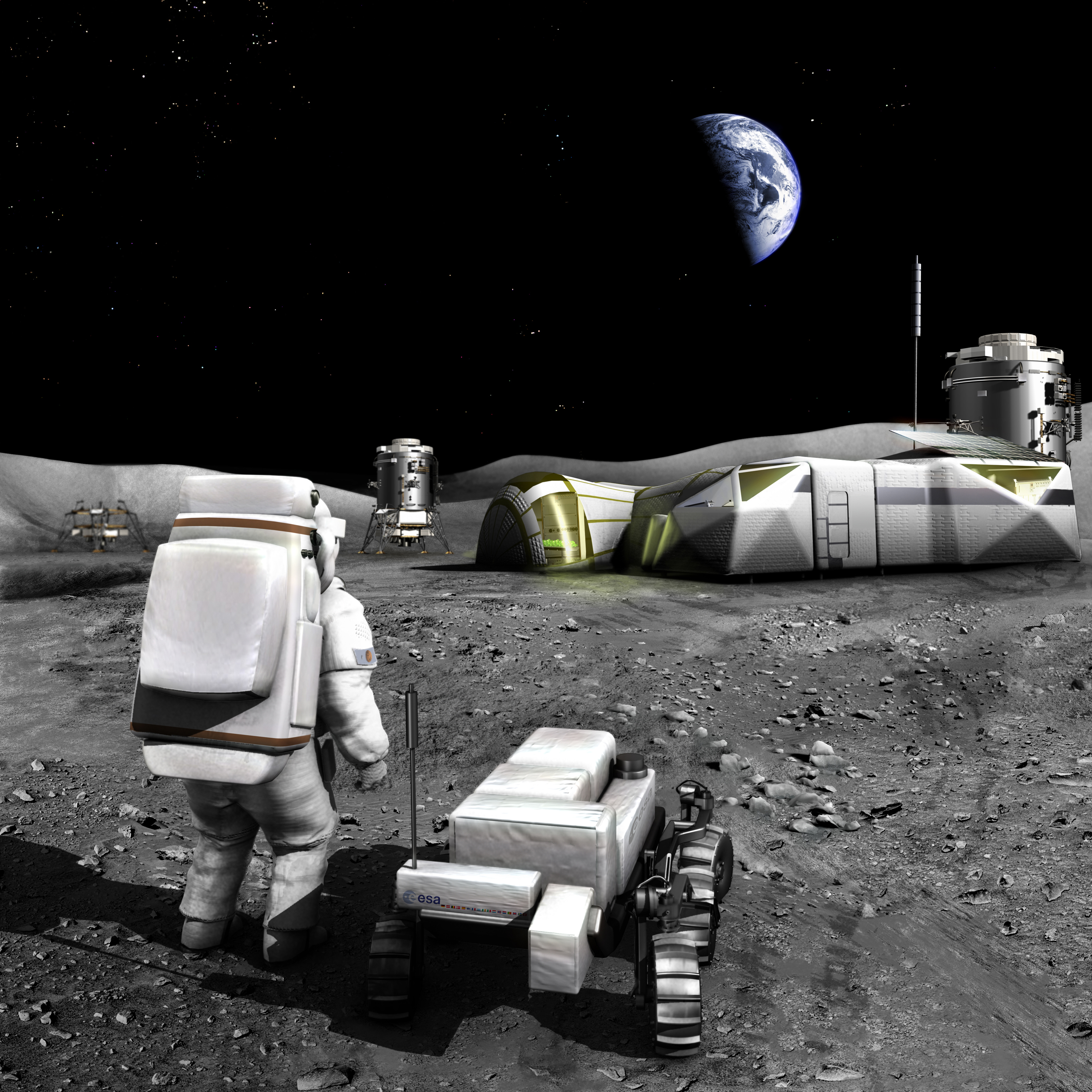Lunar exploration is struggling with the prejudice that we know all about the Moon – far from it! There are new scientific findings based on the analysis of Apollo samples that call in question the generally accepted theory about how the Moon formed. Also, scientist from Europe and in the US have just started to investigate the geochemistry of the Moon. ESA has proposed a highly interesting lunar lander mission, which was unfortunately rejected by its member states. The Lunar Lander was supposed to test how sustainable exploration can take place on the lunar surface. It is important that European states do find a possibility of a substantial lunar mission in the future, as we have to go back to the Moon, if only to prove to our children that is indeed not made of cheese.
The Legacy of Apollo

A part of the lunar surface imaged with the high resolution camera of the Lunar Reconnaissance Orbiter. All craters in the image are the result of meteorite impacts. Source: NASA
The moon is the only extended object in the night sky. As such mankind has aways wondered about its formation. In the natural science view of the world this quest is expressed in analyses of the available data. Already before the first probes or human missions have reached the Moon, there were two important facts known about the Moon: Its surface is heavily cratered and its average mass density is only 60% of that of Earth.
The observation of craters was attributed to volcanic activity. The low bulk density, in particular in comparison with other planets of the Solar System, however, remained a mystery: Mercury, Venus and Earth all have roughly the same density – about 5 grammes per cubic centimetre. Further out the density drops steeply with solar distance: Mars 4, dwarf planet Ceres 2, Jupiter 1.3, and Saturn 0.7 grammes per cubic centimetre. This hints towards the distribution of chemical elements with different masses in the solar nebula. Despite the fact that the Moon is approximately at the same distance from the Sun as Earth, it possesses a significantly lower density. It thus lacks heavy elements.
When the mighty Saturn V left the launch pad on July 16th, 1969, a new chapter was opened in the scientific understanding of the Moon. Already before the mission had scientists from the US – initially Daniel Barringer and later Eugene Shoemaker – postulated the theory that the craters on the Moon have not formed through volcanic activity, but by meteorite impact. Those colleagues had the opportunity to put together the evidence on Earth, where they could establish the different geologic contexts of volcano and meteorite craters: close to meteorite craters they found heavily shocked quartz rocks that could have formed under the extreme temperatures and pressures of a meteorite impact. This was widely accepted. The theory that also the lunar craters are the product of meteorites was rejected by the science community. Shoemaker cold not convince his colleagues at the time. Now it was the Apollo astronaut’s turn to explore the geology of the fractured lunar surface. All together they brought back 382 kilogrammes of lunar rocks and dust in the time frame between 1969 and 1972. This precious set of samples is still analysed in terrestrial labs to the present date, and it has a lot to tell about the story of the Moon – as we will see in a moment. Immediately after the first lunar rocks were split in the lab the diagnosis was clear: shocked quartz – no matter where people looked with the microscope. Like many times before natural science went through a shift of paradigm. Meteorites were the main actors of planetary surface gardening – not volcanoes.
But the lunar rocks brought more surprises: albeit being very dry – terrestrial rocks carry roughly one per mill water in form of hydrated minerals – they were isotopically related to terrestrial material. The rocks can be linked to a certain location of formation in the solar system through their abundance of the stable isotope of oxygen 18O to the most abundant isotope of this element 16O. The ratio 18O/16O of the samples returned by Apollo are identical to those of samples from the Earth. This, now, is an interesting mystery to be solved: Earth and Moon are geophysically (isotopically) related, but geochemically distinct. This apparent paradox at the time proved all theories of lunar formation wrong: A gravitational capture of the Moon could not explain the identical isotopic properties. A spin-off of the Moon from a fast rotating liquid Earth (fission theory) could not explain the different geomchemistry, as it requires a formation from the same original material. A accidental concurrent coagulation of the Moon and the Earth was rejected for the same reason.
Was remained was an initially ridiculed theory from the 1940ies by R. A. Daly, which is summarized here in a somewhat updated form.
A few tens of million years after the Sun had formed, there were 20 protoplanets circling the Sun. Together with the proto-Earth – let’s call her Gaia – another protoplanet formed at the same distance from the Sun – let’s call her Theia. Due to the residual gas drag in the solar nebula Theia was moved to one of the triangular points of equilibrium of the Sun-Gaia-Theia three-body system. There relative trajectories are stable in a certain range of mass ratios. The growth of Gaia and Theia was however not yet complete. When Theia grew too heavy the amplitude of its oscillation along Gaia’s orbit increased. One day – roughly 4.6 billion years ago disaster struck: Theia came in for a grazing impact onto Earth, was consumed by her and formed together with Gaia Earth – ejecting large amounts of her mantle and crust, but not of her core, in the process. The mantle and crust material formed a debris disk around the newborn Earth. However, the rocks in the disk were lacking hydrated minerals, because during the high velocity impact of Theia (it must have been more than 10 kilometres per second) extreme temperatures were reached that destroyed all hydrated minerals. Iron was underrepresented, too, because the Earth’s core remained unaffected. In the next few million years the debris disk formed the terrestrial moon – now dry and with little iron in it – albeit geophysically related to Earth. With that, the mystery around the formation of the Moon was apparently solved.
Where is Theia?

A picture of orange soil made by Harrison Schmitt on December 13th, 1972 at shorty crater in Littrow-Taurus. Source: NASA.
Die story that raises doubt with the well-established theory of a giant impact origin of the Moon began on December 13th, 1972 at 17:18 European time when Harrison (Jack) Schmitt – the first and so far last scientist ever to walk on the Moon – said to his commander and friend Eugene Cernan: “Okay, I’m going to take a pan while I’m waiting for you.”
Cernan: “OK! OK.”
Schmitt: “Oh hey! Wait a minute …”.
Cernan: “What?”
Schmitt: “Where are the reflections? I’ve been fooled once. There is orange soil!!”
Cernan: “Well, don’t move it until I see it.”
Schmitt: “(Very excited) It’s all over!! Orange!!!”

Microscopic images of pre-reuptive crystals in the volcanic glass found in the orange soil. The black scale bars are 10micron in size. Source: Hauri et al., Science, 333, 213, 2011.
What the two of them had found and initially had taken for oxidized minerals were soil full of volcanic glass beads. A sample of those beads turned out to be one of the most significant discoveries of the Apollo program me – only 39 years later. The analyses of the 1970ies and 1980ies confirmed that the glass beads were as free from iron and hydrated minerals as lunar basalt rocks that make up the bulk of the Apollo samples. It took an analysis technique developed in the second half of the 1990ies – time of flight mass spectrometry (TOFSIMS) to make an astonishing discovery: A team around Erik H. Hauri of the Carnegie Institution of Washington found that the glass beads contained pre-eruptive olivine crystals. Those pre-eruptive crystals form in the magma reservoir of a volcano and encapsulate the magma so that even after the eruption the pristine magma is preserved and no further weathering – for example out-gassing of volatile compounds – in the near-vacuum of the surface occurs. The ancient magma preserved in those crystals was analysed by Hauri et al. They found an amazing result: it was as wet as terrestrial mantle material! While this find does not change the fact that lunar surface rocks (mainly basalts and plaioglase feldspar) are bone dry, but this dryness can now be interpreted as a result of the continuous out-gassing of volatile elements. An alternative – perhaps even more intriguing – interpretation is that the orange soil is a sample from a particular magma that is derived not from the average lunar mantel, which could still be dry, but from a part of the mantle that was not totally dehydrated by the giant impact. In fact, this part of the mantle could be a pristine fragment of the mantle of Theia, which was not broken up but survived the impact. Ultimatively those are all interesting speculations, but in order to obtain a scientific answer, more sampling is needed! Apollo 17 has demonstrated that the best way to obtain paradigm-changing samples is by putting the scientists in direct contact with the object of investigation – in this case the lunar surface.
Quest into the Known Unknown

Vision of an international research base on the Moon. Source: ESA
Perhaps it is true that the Apollo missions and samples do not draw the full picture of the Moon. After all, due to constraints coming from celestial mechanics and the spaceflight operations of the day they could land only near the lunar equator. The Moon, however, is a whole terrestrial body with polar regions, high lands, volcanic domains, and impact basins. While its geology appears to have died down roughly a billion years ago, but on the almost 40 million square kilometres of its surface there is a geologic diversity that has to be understood as a whole.
Because of that in the US there is new scientific interest in the Moon: NASA proposes to establish a gateway station at the far-side Lagrange point of the Earth Moon system. This station will be supplied by the heavy lift launch vehicle SLS (“Space Launch System”) and human crews will reach it using the Orion capsule also currently under development. Europe has a role in this as well, as ESA plans to supply the service module for the Orion vehicle. Launching from the gateway station there is global access to the lunar surface, thus there is no restriction to the equatorial or polar regions. The Lagrange point also offers an anytime-return abort scenarios for astronauts on the lunar surface, so that in case of an emergency crew do not need to wait for the Moon to rotate them into the orbital plane of an orbiting command module. A proposal by ESA called “Lunar Lander” to also develop knowledge for the logistics towards the lunar surface has unfortunately been rejected in the ESA ministerial in Naples in November 2012. This means at least a serious delay.
Whatever the path will be lunar exploration will take in the coming years – the Moon remains a piece of little explored real estate in our back yard – a celestial body on the fractured surface of which the history of the solar system is engraved. The Moon is for the history of the Earth what Troy was for the history of the ancient world: we only miss a new Heinrich Schliemann.

Discussion: no comments